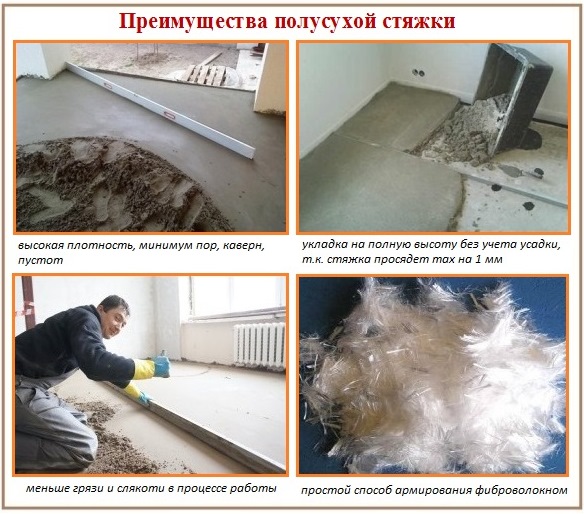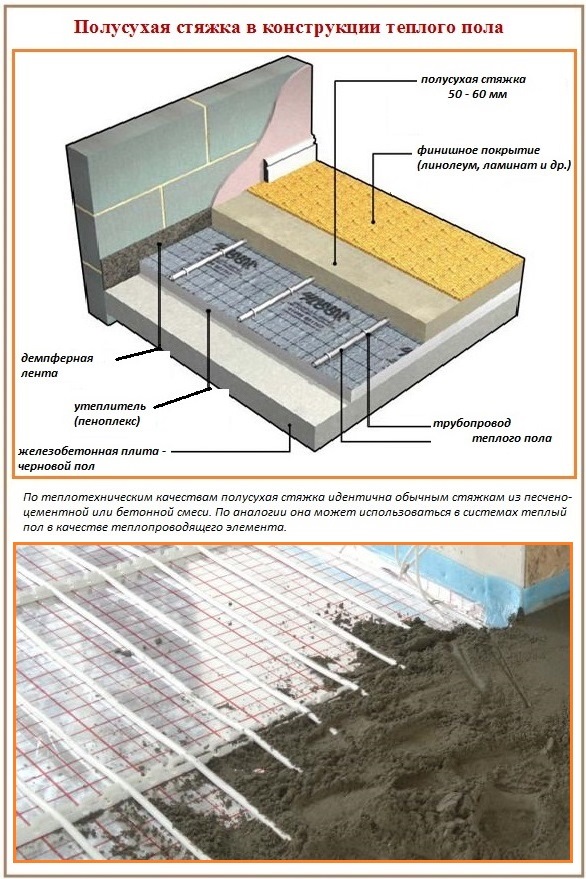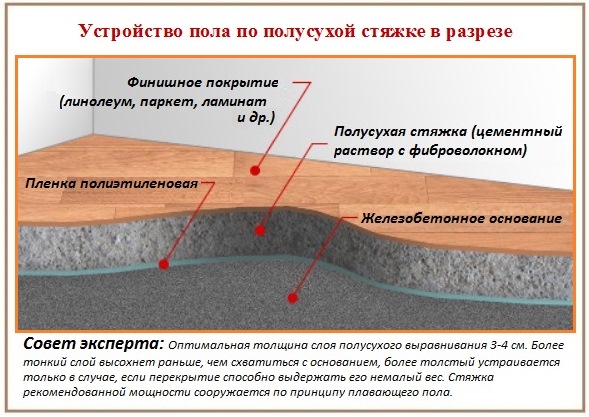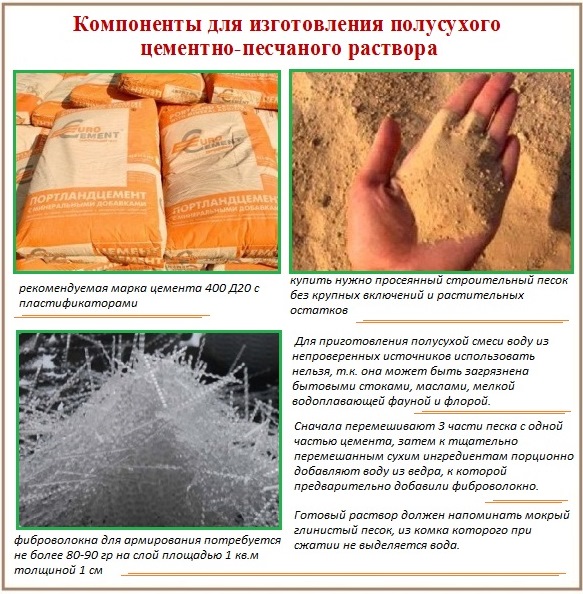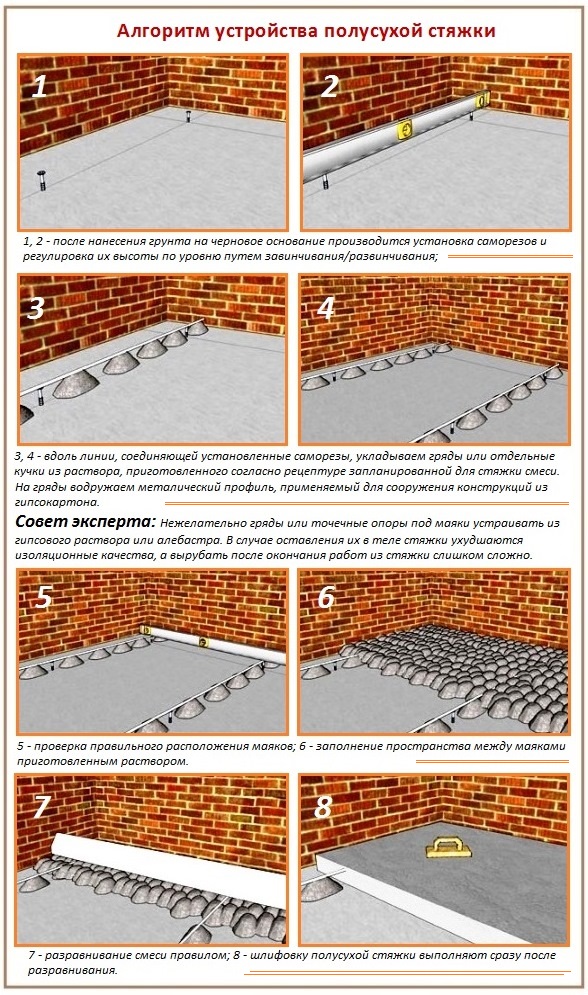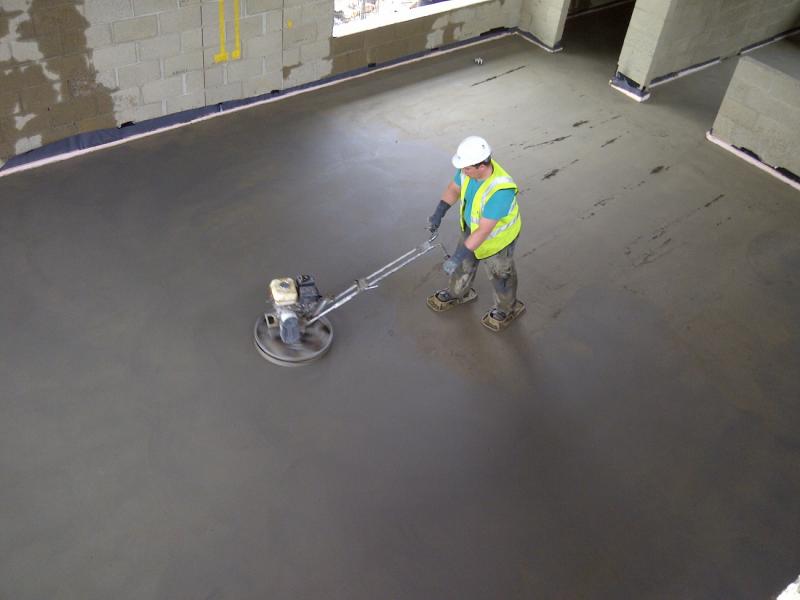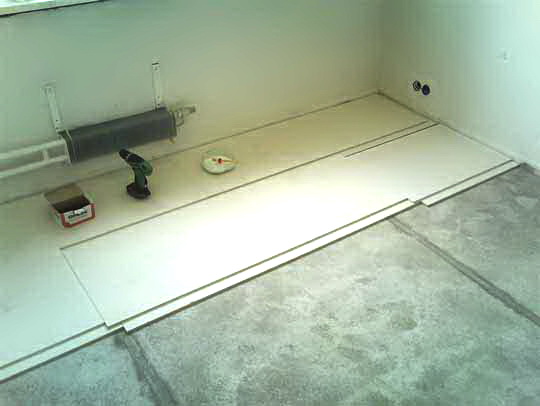Semi-dry floor screed device: secrets of the right technology + work algorithm
The semi-dry screed technology is based on the principles and rules of the well-known pouring floor with cement-sand mortar or concrete. By analogy, it is used to level the rough foundation, serves as a foundation slab or polished industrial floor. The mixture formula has undergone changes, which led to the modernization of the technological principles of pouring. Let's take it apart and sort it out in neat shelves, how the relatively new technique differs, how a semi-dry floor screed is made, how it attracts builders and owners of urban and suburban real estate.
Content
The root differences of a semi-dry alignment scheme
The term "semi-dry screed" is obtained by reducing the amount of water used in the preparation of the solution. When mixing, only the minimum of a given liquid is required, which is required for hydration of the cement molecules, i.e. to engage them in the formation of strong crystalline bonds.
Pros of a semi-dry alignment option
Having parted with excess moisture, the mixture, which turns into a cement stone as a result of hardening, “eased”, both by the criteria of the initial weight and the complexity of laying. And at the same time I got a number of significant advantages, such as:
- increased density, directly proportional to the strength of the future cement structural element or construction object. Because only as much water is used as there are cement molecules ready to contact it in the mixture; there is no traditional evaporation of unbound moisture. So, there will be no extra voids, small caverns, pores. Less pore - higher density - stronger result;
- the absence of shrinkage, directly related to the reduction in the hardening mass of pores;
- optimized maturing rates for screed due to the exclusion of a long evaporation process;
- relatively “clean” working conditions without sticky dirt and dampness;
- humidity level, not prohibiting associated finishing operations in the room.
It is important that with old methods of pouring a cement floor, damp often became the cause of damage to constructed structures, especially those installed before pouring wooden window frames and door frames. Storage of building materials in neighboring rooms was also not strongly recommended. With a semi-dry version of these problems are gone.
Overwrite the non-shrinking leveling layer immediately after drawing the rule. You can move around the arranged semi-dry screed literally after 12 hours. In order to finish finishing the equipped room, if the work is not related to laying the finish coating, you need to wait only a day. Finishing the floor can begin much earlier than with outdated schemes.
The start of the final work on the installation of the floor depends on the quality characteristics of the flooring to be laid:
- laying "indifferent" to the excess moisture of granite and floor tiles can begin in a couple of days;
- linoleum flooring can be safely started a week later;
- with the installation of the laminate floor and with the laying of the parquet board, you will have to wait 28 days, laid down according to the technological requirements, usual for all cement-sand screeds. Better longer, preferably 40-43 days.
The assurance that the laying of any finishing coating can begin in two days, consider it a provocation. Moisture during the month will be allocated anyway, however, in a reduced volume.
Noteworthy Cons
There are many pluses, they will undoubtedly drag the scales onto which we mentally hoist the shortcomings of the semi-dry floor screed. However, there are disadvantages, and performers can’t forget about them. The list of negative aspects includes:
- the density already recorded in pluses, due to which the mixture spreads worse, sometimes creates rounded shapes in the mating zones of walls and floor, stubbornly does not want to independently fill in the corners;
- the inappropriateness of a hand-made construction when arranging large areas, for example, over 75 m²;
- Limitations of the lower limit of the layer power are not less than 30 mm in height, the optimum thickness is 40-50 mm.
The first not too attractive quality is fought by enriching the mixture with plasticizers, which should be introduced according to the recommendations of their manufacturer. The difficulties in the field of angular conjugation are handled in the simplest way: by ramming the leveling mass along the perimeter immediately after laying it in a suitable place. It is useless to resist the second negative argument - it’s better to hire a team with a pneumatic stacker, it will be cheaper and faster. But the last drawback deserves careful study, because it is he who determines the technology of the device for screeding from a semi-dry mixture.
Optimum thickness and reinforcement
Because moisture in the leveling mass is small, hardening occurs at an accelerated pace. With little power, the screed will dry out before grasping the base. Therefore, it exfoliates and begins to “cobble” under the feet advancing on it. The layer is thicker than 5, max 7 cm will be quite heavy, because each cm of the thickness of the cement floor presses on 1 m³ of flooring weighing 90-120 kg. Therefore, if it is required to gain the necessary floor height, first the base is covered with expanded clay or poured with expanded clay concrete, then a semi-dry solution is laid.
Once the screed from a semi-dry solution is supposed to have 4-5 cm of power, then the scheme of the device is deliberately determined. This is a floating floor, not attached to either the walls or the base. The screed is cut off from the draft base with a waterproofing layer. They are separated from the walls by a polystyrene foam stopper installed around the perimeter, at the same time preventing the passage of sound waves. The floating system prevents stress in the drying screed, tearing the monolith in case the layer is stuck to the wall. Stress was excluded, which means there will be no cracks, in order to deal with them, fiber is additionally introduced into the semi-dry screed.
Fiber fibers are rapidly replacing the usual reinforcing mesh from the technological scheme, because:
- it is much easier to add them to the composition during kneading than toiling with delivery to the object and device of not too convenient and expensive mesh reinforcement;
- thin polypropylene threads randomly located in the hardening mass bind the cement stone ingredients in all possible directions;
- fibers prevent cracking, in contrast to a mesh that resists the effects.
The use of reinforcing mesh is not prohibited, but not very reasonable.
Home craftsmen who want to necessarily apply a mesh reinforcement element, have to build a semi-dry type of screed in three labor-intensive stages. First, by all rules, lay 2-3 cm of the base layer, then a reinforcing mesh with the connection of its parts with wire, at the end of 2 cm of the upper leveling layer.
Semi-dry screed algorithm
As without a preliminary shelling there is no high-quality attack, so a screed should not lie without carefully completed preparations. Before you start the construction of a semi-dry screed with your own hands, we will conduct a rigorous floor diagnosis. We will reveal the peeling parts of the cement base by tapping with a hammer, mercilessly remove them with a perforator and fill the recesses with a cement mixture. We knock down tangible bulges, open and repair cracks.
Cement mortar must be processed to the line connecting the walls and floor, even if cracks in the area of their joining is not observed.
Upon completion of the repair operation, remove stains of grease, oil paint, carefully vacuum the subfloor.
Secrets of making a dry mix
You need to stock up on Portland cement of the recommended brand 400D20, buy river or washed quarry sand and additives to improve flowability. It is advisable to rent a concrete mixer, however, for lack of useful equipment, you can use a large plywood sheet with boards that are knocked together from the boards, coated with a mixture at the base.
Material requirements for mortar:
- The prepared sand should have a particle size modulus of up to 2.5. The limit of finely dispersed clay inclusions in the sand is 3%, no random streaks of peat and plant debris should be. Natural humidity is recommended, but this parameter is extremely unstable, therefore no one gives the exact values of the amount of water in a semi-dry cement-sand mass. Everything as sappers by eye and touch will need to be determined.
- We purchase cement in factory intact packaging with a reasonable shelf life. When using a PC with a recommended brand, the resulting solution will correspond to a cement grade of 200M. If we take a PC with the designation 500D20, with equivalent proportions we get a 350M cement mix grade suitable for operation in areas with difficult conditions.
- We reject water from unverified water bodies; it may be contaminated with technical or biological waste. A simple plumbing option will do.
In the middle of the prepared plywood sheet, we arrange a kind of volcano, falling asleep alternately with three shovels of sand and a shovel of cement to the required volume. We mix the “dry” components, then gradually pour in the water with fiber added in advance to it. According to the technology of making a mixture for a semi-dry screed, water is added until a sandy sand texture is obtained - i.e. clay clay sticking together into a lump, upon compression of which moisture is not released, and the lump itself retains the shape transferred to it by hand.
Due to the instability of the humidity of the sand, water is added “by eye”, therefore it is very easy to overdo it. In the case of moisture from a lump of semi-dry solution, add dry components in the indicated proportions, but in reduced volumes. We mix polypropylene fiber into each bucket of water so that it is evenly distributed over the entire mass of the preparation. It will be necessary to fill up in one bucket approximately 80 gr., No longer makes sense. The exact fiber consumption per cubic meter of mixture is indicated by the manufacturer on the packaging.
Walkthrough for independent work
The production of a semi-dry type screed in a mechanized way by kneading and feeding the material with a pneumatic machine is carried out immediately to the planned value. In contrast to the mechanized system, the “manual” method is performed in layers: first, the lower part with the tamping of the solution, then the upper layer with a broach rule and simultaneous grinding. The semi-dry mortar, which is necessary for the leveling mass, begins to lose in approximately 45-60 minutes. Therefore, the finishers need to think over their responsibilities in advance and hurry up during the screed construction.
To lay the solution initially around the perimeter, as some craftsmen advise, it is possible only if the leveling layer is completely applied to the floor of the room in an hour. If more time passes, a hardened edge will appear on the laid mixture, and because of it, a completely unnecessary seam and path for the penetration of cold.
Everything was planned, the mixture was prepared, proceed:
- we cover polyethylene, ruberoid or hydroisol on the floor so that in the end the waterproofing strips form a pallet with sides on the walls 15 cm high, the strips of rolled material are laid with overlays and fastened with adhesive tape;
- along all walls we install a polypropylene insulating tape on the edge, you can cut it into strips of the required size Isolon yourself, the recommended thickness of the tape is 0.8-1.0 cm, its width is 10 cm;
- on top of the waterproofing, in accordance with the marks of the screed height, previously marked on the walls with a laser device or a simple level gauge, we arrange “rail” beacons from the beds of the mortar and guide profiles jammed on their crest. We establish linear beacons so that the working rule can rest on both adjacent rails, and between the wall and the guide it is 20-30 cm;
- throw a mixture with a shovel, not reaching the mark controlled by the beacons, immediately ramp it up, urging additional assistants;
- on a compacted surface we fill in a semi-dry solution above the level of the beacons, level the screed with simultaneous compaction;
- grind the formed screed immediately;
- a day later, in rooms with an area of more than 12-15 m² along the walls we cut expansion joints, a depth of a third of the height of the leveling layer, about 3 mm wide.
We cover the result of our work with polyethylene with overlapping sheets, leave for a week, if everything is in order with the external conditions necessary for normal hardening. In the heat, the screed will need to be moistened for 5 days after the device, so that it naturally hardens and does not "spin" and does not crack.
Compliance with the rules for laying a semi-dry mixture will provide an excellent result, knowledge of the principles of the device will help to monitor the work of a hired team of builders. Independent home craftsmen, before serious finishing of the property, can be preliminarily trained on arranging paths in the garden, building for them not beacons, but formwork from the board. Valuable experience will help in further work.

